Visitors to Sighisoara, Romania, one of the most evocative Gothic cities in Transylvania (central-western Romania), might not be surprised when they come across a statue of Dracula and learn that the city is his birthplace. With its medieval walled city center on top of a hill, the place seems to have just the atmosphere you’d associate with the bloodsucking aristocrat. But the 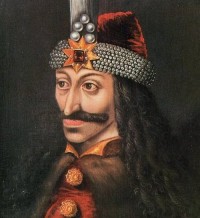 more you start to find out about the real-life Dracula, the more you realize what an improbable coincidence it is that he was born here.
more you start to find out about the real-life Dracula, the more you realize what an improbable coincidence it is that he was born here.
In fact, when walking around the cobble-stoned streets of Sighisoara, it is best not to even try to find any analogies between the historical Dracula and the fanged villain who made his debut in the 1897 Bram Stoker novel. The real Dracula, though born here, was not primarily associated with Transylvania. Instead, he found fame as the ruler of Wallachia, a different principality whose territory now makes up southern Romania. That means he was a prince – unlike his fictional namesake, who was, of course, a count. Also, the real Dracula was a Romanian, whereas Stoker’s character calls himself a Szekely (a Hungarian-speaking race). Nor was the historical Dracula a vampire, as far as anyone knows. He was, however, an impaler.
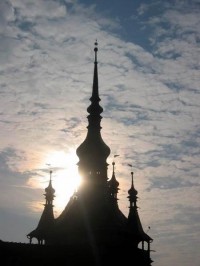 Prince Vlad III of Wallachia was called Dracula – originally spelt Draculea – because he was the son of Prince Vlad II, who was known as Dracul. That means “dragon,” and was derived from the fact that Vlad II had joined an order whose symbol was a dragon. The order was dedicated to protecting Europe from the westward expansion by the Ottoman Turks.
Prince Vlad III of Wallachia was called Dracula – originally spelt Draculea – because he was the son of Prince Vlad II, who was known as Dracul. That means “dragon,” and was derived from the fact that Vlad II had joined an order whose symbol was a dragon. The order was dedicated to protecting Europe from the westward expansion by the Ottoman Turks.
Those defensive efforts did not always go well, and when young Dracula was growing up, he spent a lot of time imprisoned by Ottoman forces. His first spell as Prince Vlad III was as the Ottomans’ young puppet, in 1448. He lost that job after the Hungarians, led by Janos Hunyadi, invaded, but he then sealed a pact with Hunyadi that brought him back to the Wallachian throne in 1456.
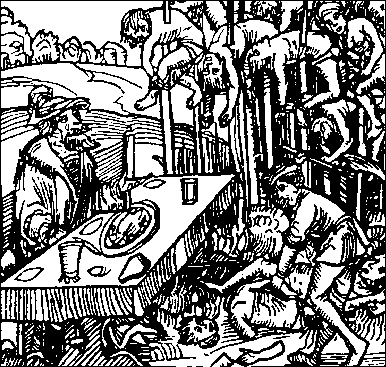 This was the start of a reign that lasted six years, during which Vlad started to be known as the Impaler. People who displeased him – be they invading foreigners or rebellious locals – would often find themselves punished by being stuck on a wooden spike driven into the earth. Similar to crucifixion, it was a slow, painful method of execution that let gravity do most of the work. Legend tells of occasions when Vlad would have many dozens of people skewered at the same time, forming forests of writhing bodies on wooden stakes.
This was the start of a reign that lasted six years, during which Vlad started to be known as the Impaler. People who displeased him – be they invading foreigners or rebellious locals – would often find themselves punished by being stuck on a wooden spike driven into the earth. Similar to crucifixion, it was a slow, painful method of execution that let gravity do most of the work. Legend tells of occasions when Vlad would have many dozens of people skewered at the same time, forming forests of writhing bodies on wooden stakes.
Dracula was not always a shrewd strategist. Anticipating a war between the Turks and the Hungarians in which his intention was to back the Hungarians, Dracula launched a bloody campaign in the Turk-dominated Balkan peninsula in 1460. The Turks retaliated against him and backed Radu, Vlad’s brother, as the new prince of Wallachia. Unfortunately for Vlad, the Hungarians, too, recognized Radu as the prince. Vlad then spent several years imprisoned in Buda (now part of the Hungarian capital Budapest) under Matthias Corvinus, King of Hungary. This may not have been a very closely confined captivity, though, as 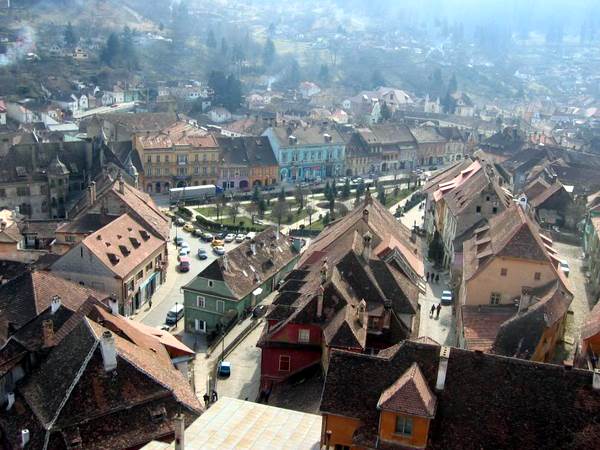 he married Corvinus’ cousin during this time.
he married Corvinus’ cousin during this time.
During the 1470s, Vlad strove to become the Wallachian prince again. The Transylvanian prince, Stephen Bathory, lent military support, and Vlad succeeded in regaining the throne. However, he only held it for a month before he was killed, in 1476. Nobody quite knows whether it was his old enemies the Turks who finished him off, or whether it was local people, still angry about his earlier cruelty.
His spirited defense of Wallachian lands has led toVlad III being considered a hero by modern Romanians. But they are not oblivious to the marketing potential caused by the confusion between him and the fictional Dracula. Many locations in the country are promoted to foreign tourists as 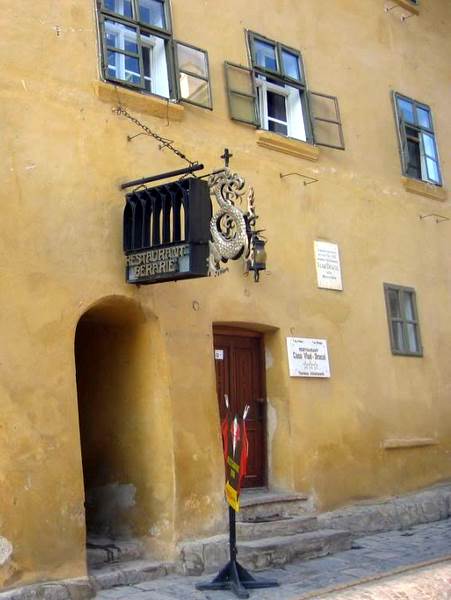 having a “Dracula connection”, despite having little or nothing to do with Vlad III. On the other hand, some Romanians are annoyed by the bloody legend that has been constructed by writers and filmmakers that bears no relation to the real Dracula.
having a “Dracula connection”, despite having little or nothing to do with Vlad III. On the other hand, some Romanians are annoyed by the bloody legend that has been constructed by writers and filmmakers that bears no relation to the real Dracula.
In Sighisoara, its possible to eat dinner in the building in which, it’s assumed, Dracula was born in 1431 and lived for his first four years. It’s a yellow building right in the historic city center. Given that a lot of central Sighisoara needed to be reconstructed after a fire in 1676, this is probably the oldest house in the area. It survived the fire and is still the same edifice Vlad knew. Once you step inside the house, though, you’re in the world of fiction, with over-the-top, vampire-themed, fake medieval décor. Confused tourists are clearly the target market!


Comments